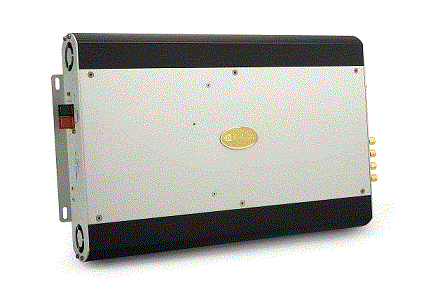| It derives from
our well known and worldwide recognized VA210, it has more available power.
We wish to introduce you this HI-END amplifier with some technical descriptions:
1 - Power Supply.
Perhaps many people ignore even its existence, as it is often underdesigned and undervalued; VA 2150 incorporate a board separated from the audio's one, capable of suppling (@12V battery) more than
1400 W of regulated and clean DC power in very short time. It works at a frequency higher than the standard one, to make it more compact, light, insensible to voltage variations of vehicle,
making useless the presence of large and expensive battery capacitors close to amplifier.
2
- Preamplifier.
It is often built with one or two Integrated Circuits. As a product of this category should to deserve, VA 2150 has been designed originally excluding this solution considered absolutely inadeguate. Instead we have recurred to the
total employ of discrete semiconductors (jfet) which, surely complicating the designer' s work, can nevertheless assure a timbrical result very different from that obtained with I.C. and that can be resumed in single word:
transparency.
3
- Amplifier.
VA 2150 can boasts a project choice absolutely not conventional, only used (and seldom) in the Home HI-END environment, not lacking in big complications in design;
COMPLETE SEPARATION OF THE SPEAKERS FROM AMPLIFICATION CIRCUIT [Total feedback = 0]. In short, this means an extreme control of speakers drived on outputs, with a realism, a speed and precision in the microdetail really exciting.
4
- Layout.
If someone was not informed also PCB (Printed Circuit Board) interfere with performance of audio signal reproduction, so we carefully selected after long test periods the best layout possible. The result is 24K gold plated FR4 (top grade), high thickness
copper traces (>80µM) material.
5
- Protection circuit.
 VA 2150 has simple protection circuit but at the same time intended not to interfere at all with the big and very fast current drive of the speakers (45 Arms peak in less than 1µS). The heat-sink system deserves a separate mention: it is studied to assure a full power running even in conditions of poor ventilation (unfortunately very frequent), avoiding incidental and premature shutdown. VA 2150 has simple protection circuit but at the same time intended not to interfere at all with the big and very fast current drive of the speakers (45 Arms peak in less than 1µS). The heat-sink system deserves a separate mention: it is studied to assure a full power running even in conditions of poor ventilation (unfortunately very frequent), avoiding incidental and premature shutdown. |
